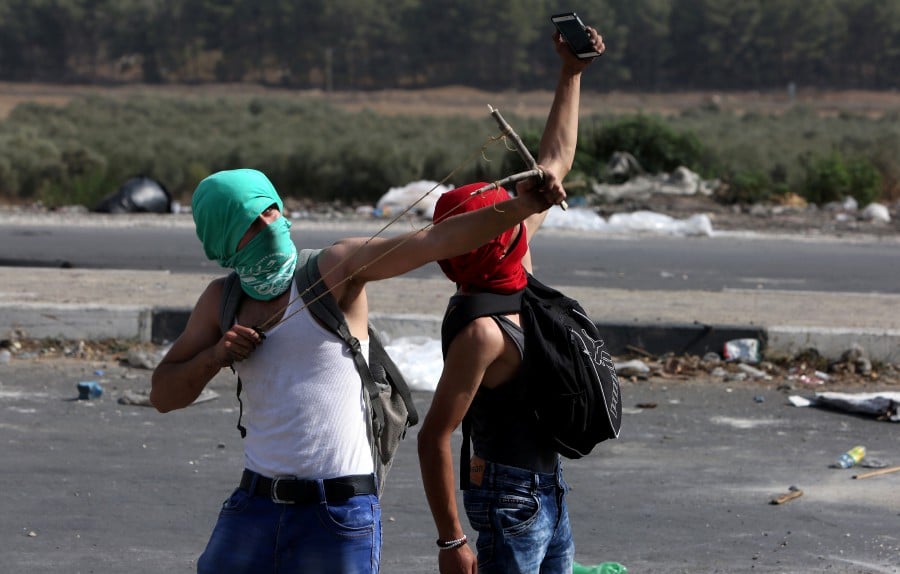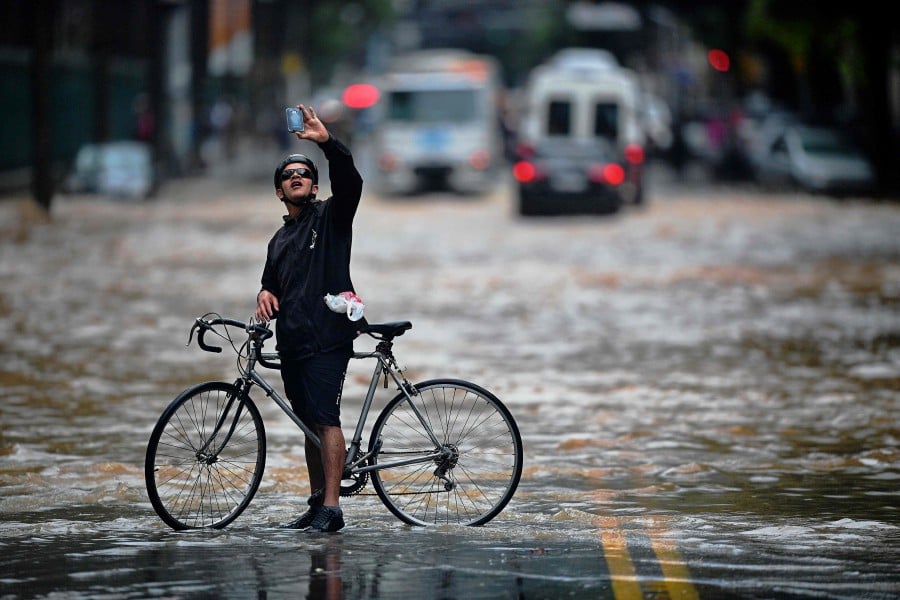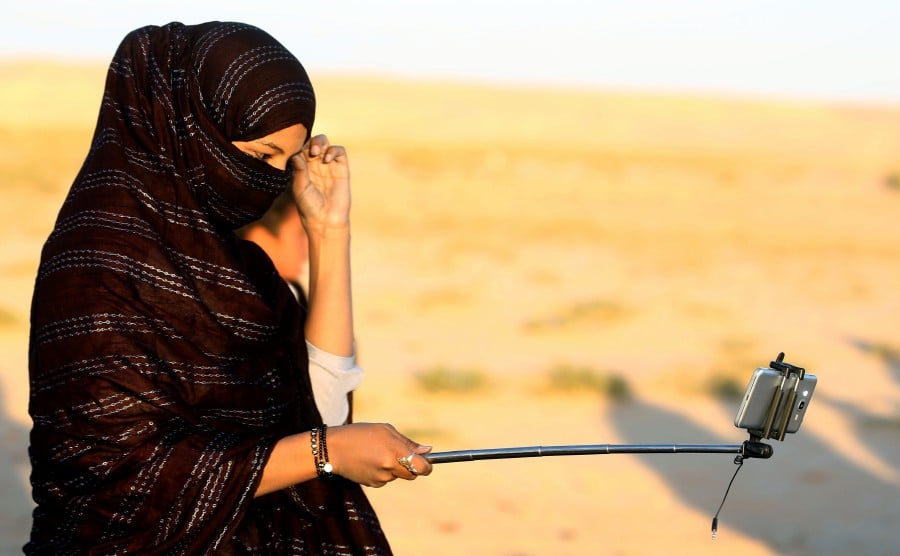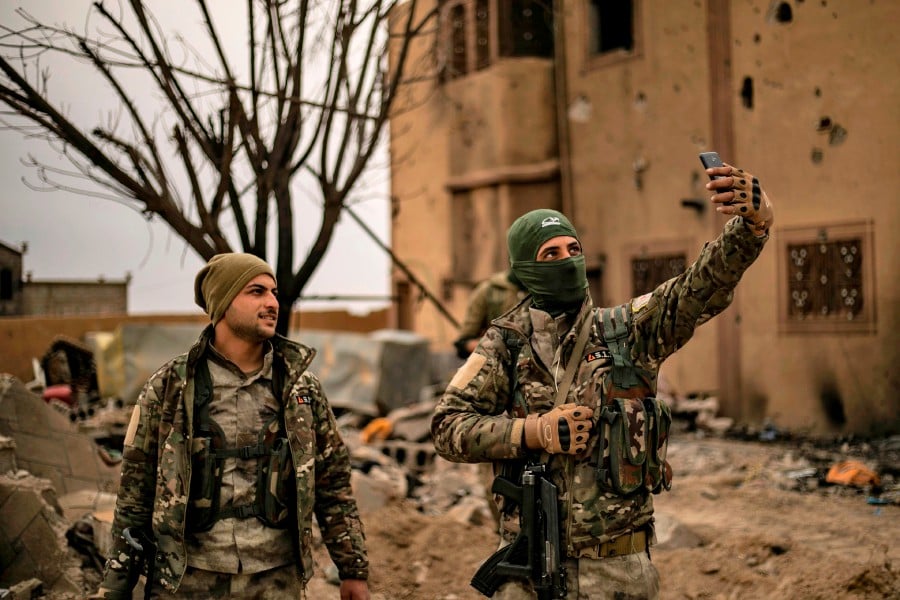Selfies kill five times more people than sharks: Report

SELFIES, which have become a global sensation in the last decade or so, have remarkably killed five times more people than shark attacks.
And the death toll has crept up incrementally each year as smartphones become more sophisticated and selfie-sticks increase the range at which people can snap themselves, prompting them to take bigger risks for the perfect shot.

A tourist taking a selfie photograph in front of the city skyline from the Mahanakorn Skywalk's observation deck area, located 314 metres above the ground, in Bangkok. -- AFP photo
Between Oct 2011 and Nov 2017, at least 259 people died taking selfies around the globe, according to India's Journal of Family Medicine and Primary Care, compared to just 50 people killed by sharks in the same period.

A tourist takes a selfie by the Christ the Redeemer statue. -- AFP photo
The report was, coincidentally, published a day after a 21-year old US student, Jordan Lindsey from of Torrance, California, was fatally attacked by three sharks as she snorkelled in the Bahamas.
While women take the most selfies, young men, who are more prone to take risks, make up three quarters of the selfie deaths – in drownings, crashes, falls or shooting accidents.

Tourists pose for a selfie photograph in front of Jerusalem's Old City from the Mount of Olive. -- AFP photo
India, with a population of more than 1.3 billion and 800 million cell phones, holds the record for the number of people dying in the act of photographing themselves, with 159 recorded so far.
That is more than half of the global total – and a testament of sorts to the nation's love of group photos and its youthful population.

Festival-goers take a selfie photograph in the sunshine on the third day of the Glastonbury Festival of Music and Performing Arts on Worthy Farm near the village of Pilton in Somerset, South West England. -- AFP photo
India has seen selfie-snapping groups of youths die when they were hit by a train or drowning when their boat sank at the moment they were clicking the shutter.
The situation has become so dire that India has set up 'no selfie' zones – 16 of them in the city of Mumbai alone.
The country came in far ahead of Russia (16 deaths), the United States (14) and Pakistan.

A masked Palestinian protestor takes a selfie as another one uses a sling shot to hurl stones towards Israeli security forces during clashes at the Hawara checkpoint, south of the West Bank city of Nablus. -- AFP photo
In Russia, people have fallen from bridges and high-rise buildings, shot themselves or even died while handling a land mine. Police issued a guide to 'selfies without danger' in 2015.
In the United States, most of those involved in selfie deaths fatally shot themselves while seeking the perfect pose. A number of people have fallen to their deaths at the Grand Canyon.

Tourists pose for a "selfie" photograph with a cell phone at the Giza pyramids necropolis on the southwestern outskirts of the Egyptian capital Cairo -- AFP photo
Rescue services in Croatia used Twitter to ask tourists to 'stop taking stupid and dangerous selfies' after a Canadian miraculously survived a 75-metre fall in the Plitvice lakes region.
In January, Taiwanese social media celebrity Gigi Wu – known as the 'Bikini Climber' for taking selfies on top of mountain peaks dressed in a bikini – died when she fell into a ravine. She was 36.
Inappropriate selfie spots
Even when they are not fatal, selfies can be extremely macabre.
In 2014, a Brazilian woman sparked rage online when she took a smiling selfie in front of the coffin of presidential candidate Eduardo Campos at his funeral.

A cyclist takes a celebratory selfie after making his way through a flooded street due to heavy rains in Rio de Janeiro, Brazil. -- AFP photo
Social media influencer Sueli Toledo also caused a stir online when she posted a picture on Instagram with the caption, 'My look today for the funeral of a super friend.'
Selfies in places deemed sacred or hallowed – especially when they honour the dead – can also raise questions.

Muslim pilgrims take a selfie at the Grand Mosque in the holy Saudi city of Mecca, on the eve of the start of the annual Hajj pilgrimage. -- AFP photo
At the former Nazi death camp of Auschwitz in Poland, visited by 2.1 million people every year, museum staff do not hesitate to contact people who post selfies deemed to be inappropriate.
From Brazil to Vietnam and Germany, witnesses to traffic accidents have posted selfies at the scene of the crash – generally seen as gauche.

A Tuareg tribeswoman uses a "selfie stick" to take a picture on a cell phone while attending a traditional ceremony in the Libyan desert in the western Awal region near the borders with Tunisia and Algeria, about 600 kilometres southwest of the capital Tripoli.
More and more, selfies – even in tourist havens – are becoming a bit of a nuisance for locals.
Residents of the picturesque Rue Cremieux in Paris were so disturbed by the constant stream of selfie-snapping tourists outside their windows that they started their own Instagram account, clubcremieux, where they publish pictures of the most absurd posers outside their doors, skewering them with barbed captions.
The same thing happened in Hong Kong, where residents of the vast multi-coloured Quarry Bay apartment complex put up signs banning photos.

Libyan youths take a selfie during the national day of the Libyan costume at the Martyrs Square in the capital Tripoli. -- AFP photo
In Brazil, several youths made a buzz on Facebook in 2017 when they posted smiling selfies taken among terrified bus passengers who had thrown themselves to the floor during a shooting.

Members of the Syrian Democratic Forces (SDF) use a cell phone to take a "selfie" photograph in the village of Baghouz in Syria's eastern Deir Ezzor province near the Iraqi border, a day after the Islamic State (IS) group's "caliphate" was declared defeated by the US-backed Kurdish-led SDF. -- AFP photo
Facing the mad frenzy of endless selfies, Vienna has launched a campaign for a digital detox.
The Belvedere Museum has put up a large copy of Gustav Klimt's classic painting The Kiss near the original and added a giant red hashtag, so that visitors can take their selfie next to the facsimile and actually look at the real work of art.
